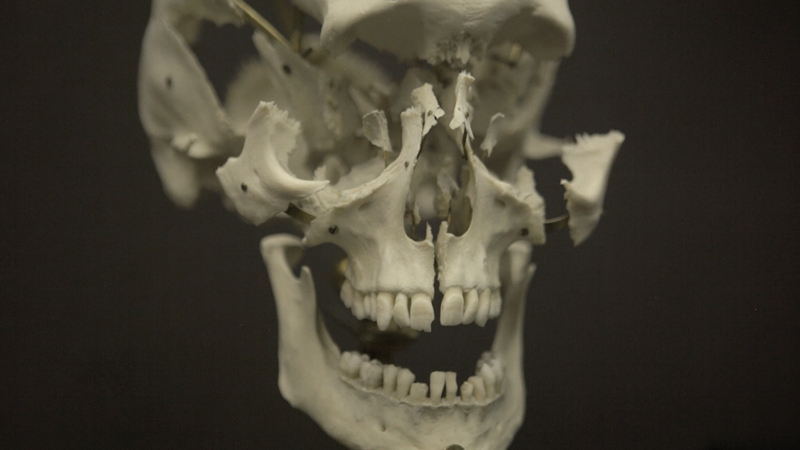One of the last lines in Anton Vidokle’s new film, This Is Cosmos (2014), continues to resonate with me: if energy is truly indestructible, where did all the energy that went into the radical social and political experiment known as the Russian Revolution go? Spoken by the artist himself with an ever-so-slight trace of a Russian accent, the line is part of a complex narrative weaving together occult ideas about the cosmos as expressed in ‘cosmism’ by the nineteenth-century Orthodox Christian philosopher Nikolai Fyodorov, with Soviet Futurism and facts about how light, including that emitted by computer screens, affects our health. Where is this energy now?
Stunning imagery filmed in Kazakhstan, Siberia and Crimea, showing cemeteries full of crescents and crosses and electrical power lines on vast steppes, rivers cutting deeply through rocks and the interior of the dome of a seventeenth-century wooden church, is combined with close-ups of faces from those places. The artist’s painter-cum-pilot grandfather and one of Ilya Kabakov’s characters – ‘the man who flew into space’ – are mentioned. Throughout the film there is a buzzing sound, like that which signals the presence of high-voltage electricity. People swimming in a river, two restless elephants in a zoo and a glance of architect, engineer and scientist Vladimir Shukhov’s famous 160-metre-tall Shabolovka radio tower (completed in 1922) in Moscow are offered too. Based on non-Euclidean hyperbolic geometry, this cone-shaped diagrid structure is an early example of advanced Soviet technology reaching far beyond the surface of the earth.
Like energy, human life should be indestructible and will always evolve but will need more space and new living conditions for vast amounts of individuals
Cosmism is the theory of universal emancipation translated into eternal life for all human beings who have ever been alive. The logic goes something like this: death is a mistake and should be overcome. If the achievement of true social equality is the goal, then eternal life must be for all. Like energy, human life should be indestructible and will always evolve but will need more space and new living conditions for vast amounts of individuals: those who have been alive, the ones who are alive now and those who will be born in the future. Spaceships and other planets will be necessary for this. Here, the energy of love will flourish, as the expected overcoming of sexual distinctions will mean a tremendous release of energy. A consubstantiation will then take place with God, the creator of the cosmos.
It is not the holistic, Christian mysticism mixed with transcendental materialism that makes cosmism curiously interesting at this moment; rather it is the idea that at the same time that some things change dramatically, others are constant. And of course, this type of theory was also put forth by Albert Einstein in terms of energy. Today, maybe we can think of it in terms of a significant difference between the bursting kind of energy that Russia experienced in 1917 and afterwards, and a sort of ‘slow’ energy. A slow energy that furthermore is dispersed and that is seeping and trickling rather than gushing forth. Nowadays the former can be discerned in engaged, localised work done by all kinds of people, ranging from activists and academics to workers and artists, who in many places seem to move towards soft mobilisation, alliances and other ways of interlinking. Even within politics there are some such signs, for example Podemos in Spain and Syriza in Greece.
Could it be that some of this slow energy finds an outlet in contemporary art too? There is certainly a lot of energy and light in the art that is around right now
Could it be that some of this slow energy finds an outlet in contemporary art too? There is certainly a lot of energy and light – plenty of suns, mirrors and lights; shiny and shimmering solar energy; and energy generated in other ways – in the art that is around right now. But what goes around comes around, and we have seen some of this before. The part of Vidokle’s beautiful film that deals with light and computer screens recalls Apolonija Šušteršič’s installation Light Therapy (1999). Made in Stockholm for Moderna Museet Projekt (which I curated), it is a fully functional light therapy centre to which art aficionados and others come to feel better in the midst of northern darkness; at the same time they are also encouraged to ponder the functions of art institutions. Just like electromagnetic hypersensitivity, a condition reported by many but not scientifically proven to be caused by electricity, light therapy is not fully accepted as a medical treatment for SAD (Seasonal Affective Disorder), or winter depression, although it is known to give results at least as good as antidepressants. Like Vidokle, I really don’t know what energy actually is, but I have a sense of where it might have gone. I am not surprised when the buzzing sound in his film does not disappear when I switch off the computer.
This article was first published in the April 2015 issue.
